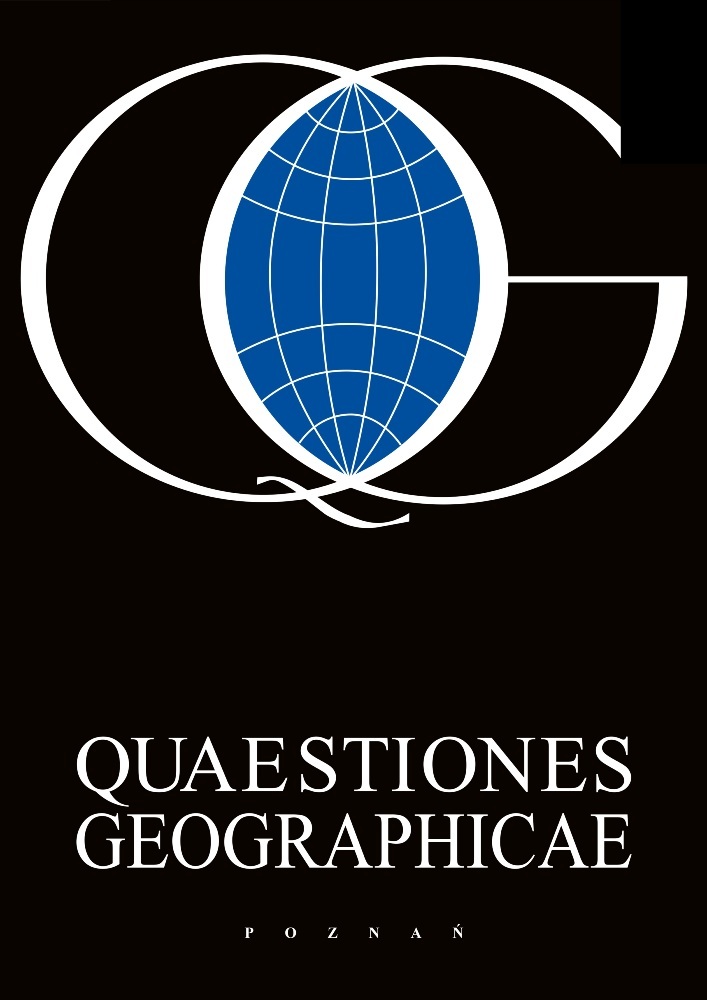Abstract
An analysis is presented of changes in the parameters of ice phenomena on selected Polish lakes over the years 1961-2010 against the background of variations in the intensity of the North Atlantic Oscillation. The following features were analysed: the start and end of ice phenomena and ice cover, their duration, and the stability of ice cover at observation sites of the Institute of Meteorology and Water Management on lakes located in various physical-geographic regions. Multi-year tendencies of change in the ice parameters under study were identified. The most statistically significant negative trends were observed for the ending dates of ice phenomena and their duration. Changes in the ice characteristics in the different NAODJFM stages were determined on the basis of their deviations: between years with high (> 1.7) and low (< -1.09) values of the winter NAO index, and from average values from the years 1961-2010. Changes in the intensity of the North Atlantic Oscillation affect all the parameters of ice phenomena except their starting dates. In a negative NAODJFM stage, ice phenomena and ice cover end later and last longer; also, the maximum thickness of ice cover is greater, its forms later and is more stable than in a positive stage and in average conditions
References
Bednorz E., 2009. Wpływ sytuacji barycznych na występowaniepokrywy śnieżnej na obszarach nizinnych środkowej Europy. Wydawnictwo Naukowe UAM Poznań, ser. Geografia 82.
Blenckner T., Järvinen M. & Weyhenmeyer G.A., 2004. Atmospheric circulation and its impact on ice phenology in Scandinavia (Conference Paper). Boreal Environment Research 9(5): 371-380.
Bryś K., Bryś T., 2002. Wpływ Oscylacji Północnoatlantckiej na zmienność warunków wilgotnościowych, radiacyjnych, dynamicznych i ewaporacyjnych we Wrocławiu- Swojcu w latach 1946-2000. In: A. Marsz, A. Styczyńska (eds.), Oscylacja Północnego Atlantyku i jej rola wkształtowaniu zmienności warunków klimatycznych i hydrologicznychPolski. Akademia Morska w Gdyni, Gdynia: 147-160.
Choiński A., 2006. Katalog jezior Polski. Wyd. Nauk. UAM, Poznań.
Choiński A., 2007. Limnologia fizyczna Polski. Wyd. Nauk. UAM, Poznań.
Choiński A., Gałka M., Ławniczak A.E., 2006. Przykłady zróżnicowania grubości pokryw lodowych wybranych jezior. Badania Fizjograficzne nad Polska Zachodnią, GeografiaFizyczna 57: 15-20.
Choiński A., Kolendowicz L., Pociask-Karteczka J., 2009. Zjawiska lodowe na Morskim Oku jako wskaźnik zmian klimatu w Tatrach. In: A.T. Jankowski, D. Absalon, R. Macowski, M. Ruman (eds.), Przeobrażenia stosunkówwodnych w warunkach zmieniającego się środowiska. Wyd. Wydziału Nauk o Ziemi UŚ: 71-77.
Choiński A., Ptak M., 2012. Variation in the ice cover thickness on Lake Samołęskie as a result of underground water supply. Limnological Review 3: 133-138.
Clifton W.J., 1875. Ice phenomena in the lake district. Nature. 11(277): 309-310.
Falarz M., 2007. Snow cover variability in Poland in relation to the macro- and mesoscale atmospheric circulation in the twentieth century. International Journal of Climatology. 27: 2069-2081.
Girjatowicz J.P., 2003. The influence of North Atlantic Oscillation on ice conditions in coastal lakes of the Southern Baltic Sea. Annales de Limnologie 39(01): 71-80.
Górniak A., Pękala M., 2001. Zjawiska lodowe jezior północno-wschodniej Polski (Ice phenomena on lasek In North-Estern Poland). Przegląd Geofizyczny 56(1-2): 91-111.
Grześ M., 1974. Badania nad termiką i zlodzeniem jeziora Gopło. Dokumentacja Geograficzna 3: 57.
Hurrell J.W., 1995. Decadal trends in the North Atlantic Oscillation: regional temperatures and precipitation. Science, 269: 676-679.
IMiGW, 1961-1983. Hydrological Yearbooks, Warszawa.
Kożuchowski K., Degirmendžić J., 2002. Wskaźniki cyrkulacji a temperatura powietrza w Polsce. In: A. Marsz, A. Styszyńska (eds.), Oscylacja Północnego Atlantyku i jejrola w kształtowaniu zmienności warunków klimatycznych ihydrologicznych Polski. Akademia Morska w Gdyni: 111-128.
Livingstone D.M., 1997. Break-up dates of alpine lakes as proxy data for local and regional mean surface air temperatures. Climatic Change 37: 407-439.
Livingstone D.M., 1999. Ice break-up on southern Lake Baikal and its relationship to local and regional air temperatures in Siberia and to the North Atlantic Oscillation. Limnologyand Oceanography 44(6): 1486-1497.
Livingstone D.m., Dokulil M.T., 2001. Eighty years of spatially coherent Austrian lake surface water temperatures and their relationship to regional air temperature and the North Atlantic Oscillation. Limnology and Oceanography 46: 1220-1227.
Magnuson J.J., Robertson D.M., Benson B.J., Wynne R.H., L Aprilingstone D.M., Arai T., Assel R.A., Barry R.G., Card V., Kuusisto E., Granin N.G., Prowse T.D., Steward K.M., Vuglinski V.S., 2000. Historical trends inlake and river ice cover in the Northern Hemisphere. Science 289(5485): 1743-1746.
Marsz A., 2001. Stan termiczny Północnego Atlantyku a reżimtermiczny zim na polskim wybrzeżu Bałtyku (problemdługoterminowej prognozy termiki zim). Wyższa Szkoła Morska w Gdyni, 107 pp.
Marsz A., Styszyńska A., 2001. Oscylacja Północnego Atlantyku a temperatura powietrza nad Polską. Wyższa Szkoła Morska w Gdyni, Gdynia.
Marsz A., Żmudzka E., 1999. Oscylacja Północnego Atlantyku a długość okresu wegetacyjnego w Polsce. PrzeglądGeofizyczny 44(4): 199-210.
Marszelewski W., Skowron R., 2006. Ice cover as an indicator of winter air temperature changes: case study of the polish Lowland lakes. Hydrological Science Journal 51(920): 236-349.
Niedźwiedź T., 2002. Relacje między NAO a wskaźnikami cyrkulacji nad Polską. In: A. Marsz, A. Styszyńska (eds.), Oscylacja Północnego Atlantyku i jej rola w kształtowaniuzmienności warunków klimatycznych i hydrologicznychPolski. Akademia Morska w Gdyni: 87-97.
Pasławski Z., 1982. Zlodzenie jezior w Polsce. Przegląd Geograficzny 27(1-2): 79-92.
Przybylak R., Wójcik G., Marciniak K., 2003. Wpływ Oscylacji Północnoatlantyckiej i Arktycznej na warunki termiczne chłodnej pory roku w Polsce w XVI-XX wiekach. Przegląd Geofizyczny 48: 61-74.
Radziejewski M., Kundzewicz Z.W., 2002. Hydrospect - program do wykrywania zmian w danych hydrologicznych. In: Z.W. Kundzewicz, M. Radziejewski (eds.), Detekcjazmian klimatu i procesów hydrologicznych. Wyd. Sorus, Poznań.
Skowron R., 2003. Ice sheet in the lasek of the Polish Lowland. Distribution, differences and trends. LimnologicalReview 3: 205-212.
Skowron R., 2011. Zróżnicowanie i zmienność wybranych elementówreżimu termicznego wody w jeziorach na Niżu Polskim. Wydawnictwo Naukowe UMK, Toruń.
Styszyńska A., 2001. Oscylacja Północnego Atlantyku a opady na obszarze Polski. Prace i Studia Geograficzne 29: 232-241.
Wibig J., 2001. Wpływ cyrkulacji atmosferycznej na rozkładprzestrzenny anomalii temperatury i opadów w Europie. Wyd. Uniw. Łódz., 208 pp.
Yoo J., D’odorico P., 2002. Trends and fluctuations in the dates of ice break-up of lakes and rivers in Northern Europe: The effect of the North Atlantic Oscillation. Journalof Hydrology 268(1-4): 100-112.
License
This content is open access.
